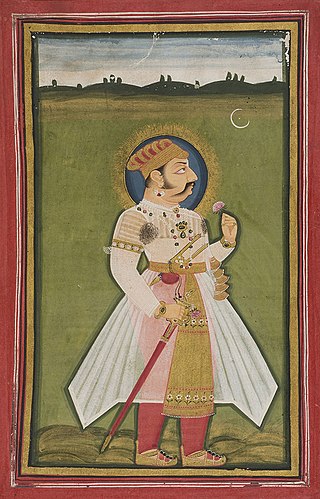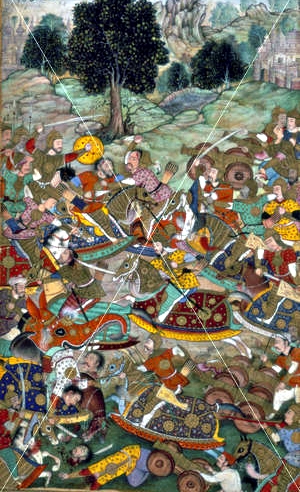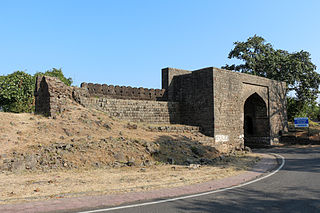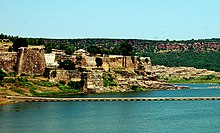
Sangram Singh I, commonly known as Rana Sanga, was the Rana of Mewar from 1508 to 1528 CE. A member of the Sisodia dynasty, he controlled parts of present-day Rajasthan, Gujarat and Madhya Pradesh with his capital at Chittor. His reign was admired by several of his contemporaries, including the first Mughal Emperor Babur, who described him as the "greatest Indian ruler" of that time. The Mughal historian Abd al-Qadir Badayuni called Sanga the bravest of all Rajputs along with Prithviraj Chauhan also known as Rai Pithaura.
Raja Shiladitya Tomar, also called Silhadi Tomar, was a chieftain of northeast Malwa in the early decades of 16th century India. He become vassal of Sanga of Mewar and remain as an ally and Sanga helped him and Medini Rai in various battles and in conquering Malwa from Sultans.

Kumbhkaran Singh (1417–1468), popularly known as Maharana Kumbha, was the ruler of the Kingdom of Mewar. He belonged to the Sisodia clan of Rajputs. It was during his reign that Mewar became one of the most powerful political powers in northern India. He is considered to be the most powerful ruler of his time in India.

The Malwa Sultanate was a late medieval kingdom in the Malwa region, covering the present day Indian states of Madhya Pradesh and south-eastern Rajasthan from 1401 to 1562. It was founded by Dilawar Khan, who following Timur's invasion and the disintegration of the Delhi Sultanate, in 1401, made Malwa an independent realm.

The Kingdom of Mewar was an independent kingdom that existed in the Rajputana region of the Indian subcontinent and later became a major power in medieval India. The kingdom was initially founded and ruled by the Guhila dynasty followed by the Sisodiya Dynasty. The kingdom came to be known as the Udaipur State after it became a princely state in the nineteenth century.

The Mughal–Rajput wars were a series of battles between the Rajput Confederacy and the Mughal Empire. The conflicts originated with the invasion of northwestern India by the Mughal ruler Babur, to which the head of the Rajput confederacy, Rana Sanga, offered staunch resistance. The conflicts went on since 1526 for over 200 years, with the Mughals having the upper hand until the death of Aurangzeb in 1707, following which they entered a declining phase and the Rajputs gained the upper hand, with the last recorded conflict taking place in 1779.
Rana Vikramaditya was the Sisodia Rajput ruler of Mewar Kingdom ,younger son of Rana Sanga and the elder brother of Rana Udai Singh II. He was unpopular amongst the nobles of Mewar. During his brief reign, Chittor was sacked by Bahadur Shah of Gujarat however Bahadur Shah was not able to hold Chittor for long and the Sisodia's recaptured it within a short time of his departure.
The history of human settlement in the west Indian state of Rajasthan dates back to about 5,000 years ago.
The Battle of Dholpur in today's India occurred between the Kingdom of Mewar, led by Rana Sanga, and the Lodi dynasty of the Delhi Sultanate, commanded by Ibrahim Lodi, culminating in a victory for Mewar.

The siege of Mandsaur was a siege laid by Kingdom of Mewar forces under Rana Sanga against Gujarat Sultanate and Malwa Sultanate. The Sultan of Gujarat left Muhammadabad and returned to his capital after Rana Sanga had returned to Mewar after his campaign in Gujarat. He was grieved to see his treasuries looted and his palace destroyed and began to think of avenging his defeat. He set about preparing a large army, doubled the pay of the soldiers, and gave them a year's salary in advance.
The Battle of Mandalgarh and Banas were two major battles fought between Rana Kumbha of Mewar and Mahmud Khalji of Malwa which resulted in decisive defeat of the latter.

The Battle of Sarangpur was fought between Rana Kumbha and Sultan Mahmud Khilji. Mahpa Panwar, who was one of the assassins of Rana Mokal, was sheltered by the Sultan of Mandu. A demand for this person was made by Rana Kumbha, but Mahmud Khilji refused to surrender the refugee. The Rana prepared for hostilities and advanced to attack Mandu. The Sultan advanced with a powerful army to meet Kumbha.
Ranmal, also called Ran Mal or Ridmal, was the Rathore ruler of Marwar from 1428 to 1438. A notable expansionist and skilled warrior, Ranmal is also noteworthy for having twice served as regent of the kingdom of Mewar under two different kings.

Hansa Bai was Rani of the Rajput kingdom of Mewar during the early 15th century. She was the wife of Maharana Lakha Singh and mother to his heir, Mokal.
Haridas Kesaria or Haridas Mahiyaria was a 16th-century Mewar chieftain, warrior and poet from Rajasthan. In the Battle of Gagron in 1519, he fought alongside the Mewar army led by Rana Sanga, capturing and imprisoning the Sultan Mahmud Khalji II of Malwa, thus quickly ending the war. He was a close friend of Rana Sanga, participating in many battles and campaigns of Mewar kingdom. He fought as a commander in many battles including Battle of Khatoli, Battle of Gagron, Battle of Dholpur, Rana Sanga's invasion of Gujarat, Battle of Bayana and Battle of Khanwa in which he sacrificed his life on the battlefield while defending Rana Sanga.

The Mewar–Malwa conflicts were a series of wars between the Kingdom of Mewar and the Sultanate of Malwa. The conflict erupted due to mutual territorial expansion triggered by both sides on each other. The war was fought in the modern-day regions of Rajasthan and Madhya Pradesh. The Rana branch of the Guhilas, following their successful recovery of the Rajput stronghold of Chittorgarh and the entire region of Mewar alongside Rajputana after the Battle of Singoli, embarked on an ambitious expansion at the cost of their neighbouring kingdoms. On the other side, with the invasion of Timur, the Delhi Sultanate grew weak and many of its provinces gained independence which included Malwa, adjacent to Mewar.
The Conquest of Ajmer was a military expedition launched by the Sultan Mahmud Khalji of Malwa aimed to conquer and subdue the region of Mewar, which was under the control of the Mewar kingdom.This military expedition was undertaken against Mewar with the intention of seeking revenge from Rana Kumbha of Mewar. It was a major military conquest carried out during the reign of Mahmud Khalji with the goal of expanding territorial control. Although Mahmud was victories in this campaign, he was not able to hold Ajmer for a longer period of time. As it was later reconquered by Rana Kumbha.
The Conquest of Mandalgarh was a military expedition led by Sultan Mahmud Khalji of Malwa against Mewar in what is now India. The primary objective of this campaign was to capture the Mandalgarh fort, which was under the command of Uparamal, a subordinate of Rana Kumbha. Mahmud Khalji marched towards Mewar in the year 1457 to achieve this goal.
The Kingdom of Mewar - Delhi Sultanate Conflict was a series of military engagements between the Kingdom of Mewar under the Sisodiya dynasty and the Delhi Sultanate from the regime of Tuqhlaq Dynasty to the succeeding ones. The conflict erupted when the Sisodiya dynasty took the reigon of Mewar from Delhi Sultanate's rule. The conflict was fought in what is today the Indian states of Rajasthan, Madhya Pradesh and Uttar Pradesh.









